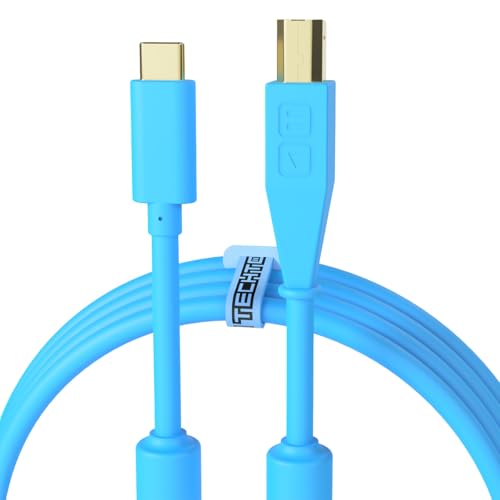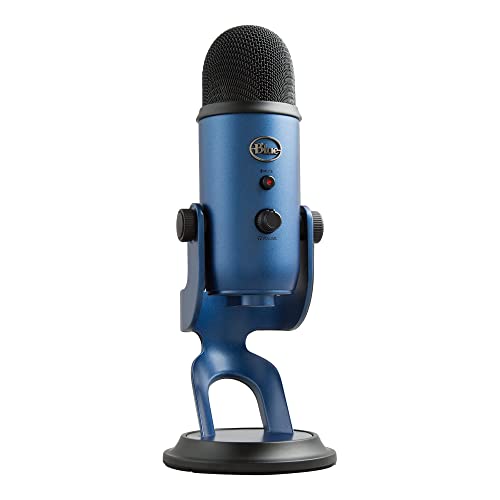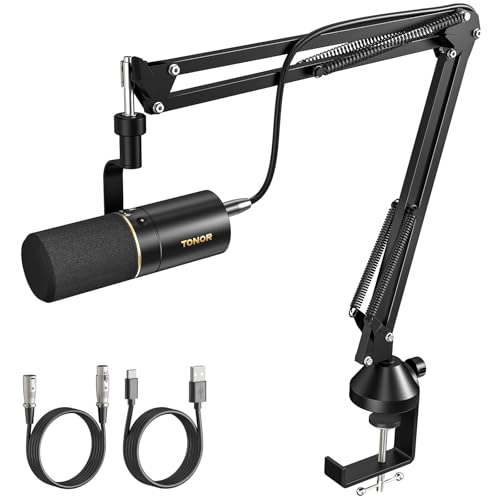As a creator, I’ve found that a well-equipped studio is key. It boosts productivity and sparks creativity. With more people working from home, having the right studio equipment is crucial.
Creators are now looking for affordable ways to set up their studios. By using the right tech tips, you can create a space that encourages innovation and success.
Key Takeaways
- Invest in essential studio equipment to boost productivity.
- Leverage tech tips to enhance your creative workflow.
- Create a budget-friendly studio that meets your needs.
- Stay ahead of the game with the latest studio technology.
- Maximize your studio’s potential with the right equipment.
Understanding Your Studio Needs
A well-planned studio starts with knowing what you need. You must think about several key factors. These will guide your choices on equipment and setup.
Identifying Your Creative Focus
Your studio’s main purpose will shape your equipment needs. You must decide if it’s for audio, video, or multimedia production. Each field has its own needs.
Audio, Video, or Multimedia Production
For audio, you’ll need top-notch microphones and audio interfaces. Video production requires cameras and lighting. Multimedia needs both audio and video gear.
Solo Work vs. Collaborative Projects
Consider if your studio is for solo work or team projects. This impacts your space size and layout. It also affects the equipment you’ll need.
Assessing Available Space
After deciding your focus, measure your space. This step is key to planning your layout. You want your equipment to fit well and leave room to work efficiently.
Measuring and Planning Your Layout
Take exact measurements and make a layout plan. Think about your workflow and how equipment will work together.
Setting a Realistic Budget
Creating a budget is essential. Knowing your audience, as Brett Sutton suggests, helps make smart choices.
Prioritizing Essential Equipment
Focus on the most important equipment first. This way, you use your budget wisely, starting with the essentials.
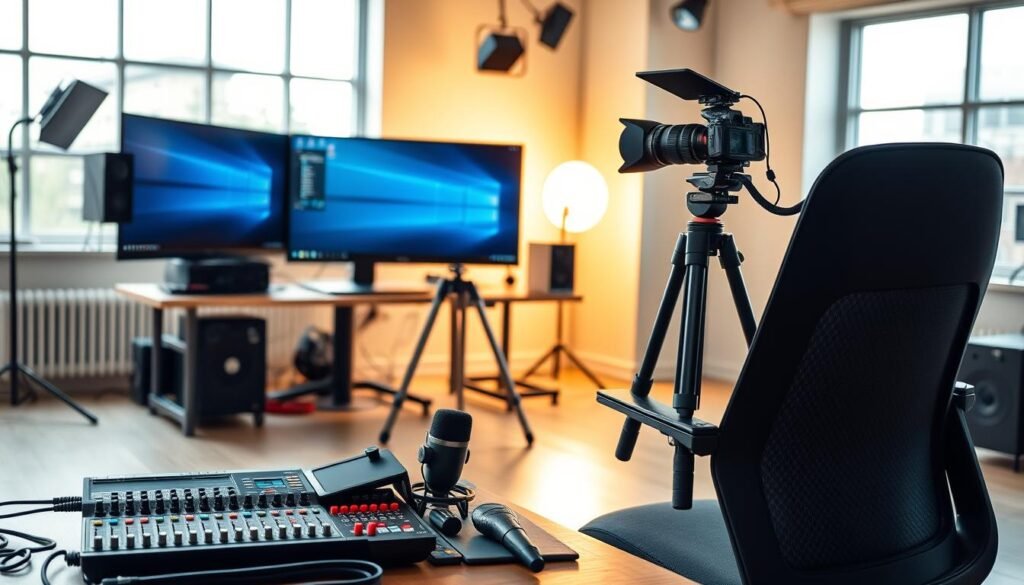
Essential Computing Hardware
To set up your studio for success, knowing the right computing hardware is key. The right tools help you work efficiently and effectively.
Selecting the Right Computer System
Choosing the right computer is a big decision. It depends on your creative needs and budget.
Mac vs. PC for Creative Work
The debate between Mac and PC for creative work is ongoing. Macs are known for their ease of use and Apple device integration. PCs, on the other hand, offer customization and are often more affordable.
Processor, RAM, and GPU Requirements
For creative tasks, a strong processor, enough RAM, and a good GPU are essential. Aim for at least 16GB RAM, but 32GB or more is better for tasks like video editing and 3D modeling.
Monitor Considerations for Creative Work
A high-quality monitor is crucial for accurate color and detail. Look at color accuracy, resolution, and screen size when choosing a monitor.
Color Accuracy and Resolution
For creative pros, a monitor with high color accuracy and resolution is a must. Choose monitors with 4K resolution and HDR for better visuals.
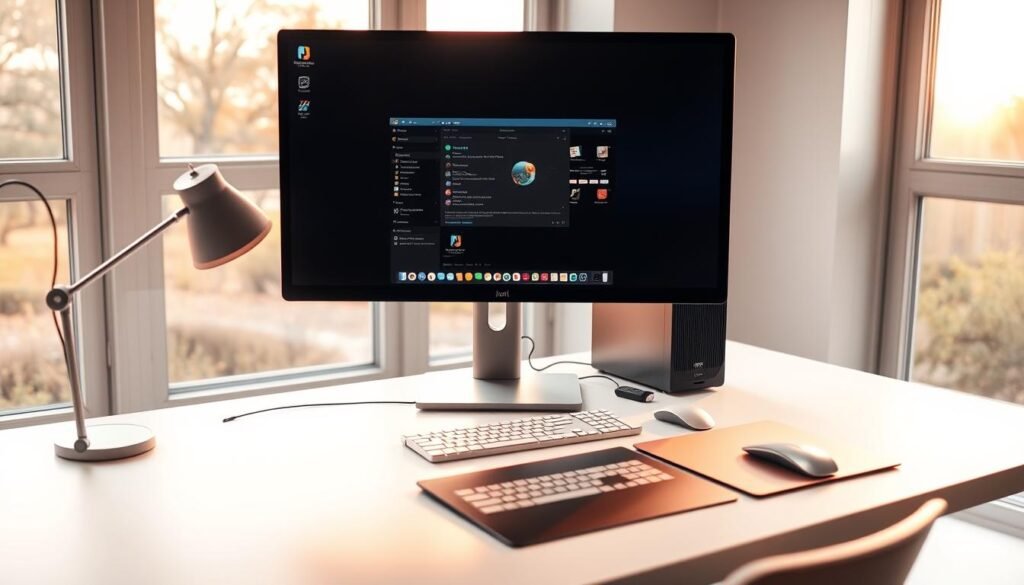
Storage Solutions for Large Projects
Storage is vital for large creative projects. Decide between SSD and HDD, and consider RAID and backup systems for performance.
SSD vs. HDD Performance Trade-offs
SSDs are faster than HDDs, making them great for quick data access in apps like video editing software.
RAID and Backup Systems
RAID systems offer redundancy and protect against data loss. Regular backups to external drives or cloud storage are also crucial for your work’s safety.
- Key Considerations:
- Processor: At least a quad-core processor
- RAM: Minimum 16GB, recommended 32GB or more
- GPU: A dedicated graphics card for graphics-intensive tasks
- Storage: SSD for faster performance, HDD for mass storage
- Monitor: High-resolution with accurate color representation
Audio Equipment Essentials
High-quality audio equipment is key for making professional content. When setting up your studio, getting the right tools is crucial. These tools help capture and produce top-notch sound.
Studio Microphones Worth Investing In
Choosing the right microphone depends on your needs. Dynamic microphones are tough and versatile. On the other hand, condenser microphones are more sensitive and detailed.
Dynamic vs. Condenser Options
Dynamic microphones work great for loud sounds and live shows. But, condenser microphones are best for capturing fine details in a studio.
XLR vs. USB Connectivity
Think about whether you need XLR or USB connectivity. XLR microphones are flexible with many interfaces. USB microphones are easy to use right out of the box.
Audio Interfaces for Professional Sound
An audio interface is vital for linking your microphones to your computer. Make sure to check your input/output needs to match your equipment.
Input/Output Requirements
Figure out how many inputs and outputs you need for your recording setup. This will help you pick the best audio interface.
Headphones and Speakers for Accurate Monitoring
For good monitoring, think about open-back vs. closed-back headphones and near-field monitor placement. Open-back headphones give a natural soundstage. Closed-back headphones block out distractions.
Video Production Gear
To make great video content, you need the right gear. The quality of your equipment really matters. It’s key to pick the best tools for your studio.
Camera Selection for Studio Work
Choosing the right camera is the first step. The camera you pick depends on what you’re making and how good you want it to look.
Lighting Equipment for Professional Results
Lighting is super important for video. It can make your content look amazing or not so good. Good lighting adds mood, depth, and makes sure your subjects look great.
Video Capture and Streaming Devices
You also need devices to capture and stream your video. These tools help you send your video to different places.
Capture Cards and HDMI Solutions
Capture cards and HDMI solutions are key. They let you get high-quality video from your camera and send it to your computer.
| Device Type | Key Features | Benefits |
|---|---|---|
| DSLR Cameras | High image quality, interchangeable lenses | Flexibility, high-quality video |
| Mirrorless Cameras | Compact, advanced features, fast autofocus | Portability, advanced functionality |
| Dedicated Video Cameras | Superior video quality, advanced video features | Professional-grade video production |
How to Equip Your Studio Like the Top Tech Professionals
Setting up a professional studio means investing in the right tools and equipment. It’s key to know what top tech pros use and why.
Industry-Standard Tools and Equipment
Top professionals use industry-standard tools for their work. Audio engineers often pick high-end microphones like the Shure SM7B or Neumann U87 for their quality. Video producers choose cameras like the Arri Alexa or Red Epic for their top-notch image.
What the Pros Use and Why
Professionals pick their gear based on their project needs. For example, a music producer might go for a top-notch audio interface like the Universal Audio Apollo for clear sound. Knowing your studio’s needs and industry standards helps you make the right choices.
Future-Proofing Your Setup
Future-proofing your studio means choosing equipment that can grow with new tech. Opting for modular systems that can be updated is a smart move.
When to Splurge vs. When to Save
Planning your budget is key when setting up your studio. It’s important to know when to spend more and when to save. Spending on high-impact items like a top camera or microphone is worth it for better work quality.
High-Impact vs. Low-Impact Purchases
Low-impact items, like studio decor, can be more affordable. Focus on spending on what really matters for your work. This way, you get the most out of your budget.
By focusing on the right tools, future-proofing, and smart budgeting, you can set up your studio like the pros. This ensures you’re ready for any project.
Software Solutions for Creative Work
Software is key for creative studios, helping artists realize their ideas. The right tools can make workflows smoother, boost productivity, and help projects succeed.
Essential Creative Applications
Studios use various software for different tasks. These include:
Audio Production Software
Ableton Live and Pro Tools are top choices for audio work. They have advanced features for recording, editing, and mixing.
Video Editing Platforms
Adobe Premiere Pro and Final Cut Pro are favorites for video editing. They offer strong editing tools and work well with other apps.
Graphic Design Tools
Adobe Photoshop and Illustrator lead in graphic design. They have many tools for making and tweaking visual content.
Productivity Tools for Streamlined Workflow
Productivity tools are also vital for managing studio work. A key tool is:
Project Management Software
Asana and Trello help organize tasks, track progress, and team up well.
A recent article shows how important the right software is for productivity. For example,
“You Can Get Microsoft Office Pro Plus 2019 on Sale for Just $30 Right Now”
shows the value of affordable software access.
Subscription Services vs. One-Time Purchases
Studios must choose between subscription services and one-time buys. Each has its benefits and drawbacks.
Cost Analysis Over Time
Subscriptions like Adobe Creative Cloud give updates and many apps but can cost more over time. One-time buys offer permanent ownership but might not have ongoing support or updates.
Ergonomics and Workspace Design
Ergonomic design is more than looks; it’s about making a space healthy and efficient. A well-designed studio boosts productivity and cuts down on discomfort and injury risks.
Desk and Chair Selection for Long Sessions
Choosing the right desk and chair is key for long studio hours. Find a chair with adjustable height options so your feet are flat or on a footrest. Your knees should be at or below hip level.
Adjustable Height Options
An adjustable desk lets you switch between sitting and standing. This improves posture and cuts down on fatigue.
Proper Monitor Placement and Lighting
Right monitor placement and lighting reduce eye strain. Place your monitor about 20-25 inches away, at a height where you look slightly down.
Reducing Eye Strain and Fatigue
Good lighting is also important. Make sure the light source isn’t directly in front or behind your monitor to avoid glare.
Accessories for Comfort and Health
Adding extra accessories can make your space more comfortable and healthy. Use wrist rests for your keyboard and mouse, and foot supports for comfort.
Wrist Rests and Foot Supports
These items help prevent strain and discomfort during long work hours.
By prioritizing ergonomics and workspace design, you can make a studio that supports your health, comfort, and productivity.
Connectivity and Networking
Connectivity and networking are key in a modern studio. They make sure everyone can talk and share data easily. A good setup is essential for your studio to run smoothly.
Internet Requirements for Professional Work
A stable internet connection is crucial for work in a studio. The article “How to Turn Off the New ‘Gemini in Chrome’ Button” from Home Tech shows why a fast internet is important.
Upload/Download Speed Needs
Studios need at least 10 Mbps upload and 50 Mbps download speeds. But, the exact needs depend on what your studio does, like video editing or cloud backups.
Wired vs. Wireless Considerations
Studios must choose between wired and wireless connections. Wired is fast and reliable, but wireless is flexible and easy to use.
Reliability and Latency Issues
Wired connections are more reliable and have less latency than wireless. But, wireless tech has improved a lot, making it a good choice for many studios.
Backup and Redundancy Systems
Studios need backup and redundancy systems to keep working. This means having more than one internet provider and backup power.
Cloud Storage Integration
Cloud storage is a must for a studio’s network. It makes backing up data and working together easy.
| Connectivity Aspect | Wired | Wireless |
|---|---|---|
| Reliability | High | Medium |
| Speed | High | Medium |
| Flexibility | Low | High |
Cable Management and Power Solutions
A well-organized studio boosts productivity. It begins with good cable management and reliable power solutions. A messy workspace can cause equipment failures and slow you down.
Organizing Your Cables Effectively
To keep your studio tidy, a strong cable management system is key. This means:
- Labeling cables for easy identification
- Routing cables behind furniture or through cable ties
- Using cable organizers or zip ties to keep cables tidy
Labeling and Routing Techniques
Good labeling and routing cut down on clutter. Use color-coded labels to tell cables apart. Make sure they’re routed to avoid interference.
Power Conditioning and UPS Systems
A power conditioning system stabilizes your equipment’s power. It guards against power surges and outages. A UPS (Uninterruptible Power Supply) system gives you backup power when the main power goes out.
Protecting Against Power Outages
A UPS system is vital for keeping your gear safe during power outages. It lets you safely turn off your equipment or keep working during brief outages.
Surge Protection for Valuable Equipment
Surge protectors are key for protecting your valuable equipment from power surges. Look for a surge protector with a high joule rating and enough outlets.
Power Strip Selection and Placement
Pick a power strip with surge protection and put it where you can easily reach it. Make sure the power strip isn’t too full, as this can be dangerous.
| Equipment | Surge Protection Rating | Power Conditioning |
|---|---|---|
| Computer System | 1000 Joules | Yes |
| Audio Interface | 500 Joules | No |
| Studio Monitors | 2000 Joules | Yes |
Budget-Friendly Alternatives
Setting up a studio on a budget means looking for affordable options. An article mentioned the JBL Flip7 Speaker for just $100. This shows there are many cheap studio equipment choices.
Quality Entry-Level Equipment
Choosing quality entry-level gear is a smart budget move. Brands like PreSonus and Focusrite offer good, cheap audio interfaces.
Best Value Brands and Models
Here are some top brands for affordable entry-level equipment:
- PreSonus AudioBox for audio interfaces
- KRK Systems for monitor speakers
- Shure for microphones
Used vs. New Considerations
Buying used gear can save money. But, it’s important to know what’s safe to buy.
What’s Safe to Buy Used
Things like microphones and cables are usually okay to buy used if they’re in good shape. But, it’s better to get computer hardware and software new. This ensures they work well and come with a warranty.
| Equipment Type | Safe to Buy Used | Recommended Brands |
|---|---|---|
| Microphones | Yes | Shure, Sennheiser |
| Audio Interfaces | Sometimes | PreSonus, Focusrite |
| Computer Hardware | No | Apple, Dell |
DIY Solutions for Common Studio Needs
DIY solutions can save money and be fun. For example, you can make acoustic treatments with Owens Corning 703 and wood.
Homemade Acoustic Treatments
To make a simple acoustic panel, you need:
- Owens Corning 703 or similar acoustic insulation
- Wooden frame
- Fabric cover
Custom Desk and Storage Solutions
DIY desks and storage can make your studio look and work better. Think about using old furniture or modular designs.
Maintenance and Upgrades
Keeping your studio equipment in top shape is key. Regular care helps your gear work better, saving you from expensive fixes later.
Regular Cleaning and Care Routines
Make cleaning a part of your routine. This stops dust and wear. For example, clean your computer’s vents to avoid overheating.
Equipment-Specific Maintenance Tips
Each piece of gear needs its own care. Clean camera lenses with a soft cloth and the right solution. Use anti-static measures for electronics.
When and How to Upgrade Components
Upgrading can refresh your setup. Know when a part is slowing you down and plan upgrades wisely.
Identifying Performance Bottlenecks
Watch how your system performs. If your computer slows you down, it might need a RAM or CPU boost.
Troubleshooting Common Technical Issues
Even with care, problems can pop up. Knowing how to fix common issues saves time and stress.
Resources for Self-Help and Support
Use online forums, support sites, and manuals for help. For tough issues, get professional advice.
By focusing on maintenance, upgrades, and troubleshooting, your studio stays productive and creative.
Conclusion
Setting up a professional studio is a big task that needs careful planning. You must understand your needs, invest in good hardware, and choose the right equipment. This way, you can make a space that boosts your creativity and work.
Remember, it’s key to know your space, set a budget, and think about the future. These steps will help make sure your studio is ready for success.
Before you finish setting up your studio, make a checklist. It should cover things like organizing cables, setting up power, and keeping things running smoothly. Following these steps will help you create a studio that meets your needs and helps you reach your creative goals.
FAQ
What are the most important factors to consider when equipping a studio?
When setting up a studio, think about your creative goals, the space you have, and your budget. These factors help you choose the right equipment to invest in.
How do I choose the right computer system for my studio?
Choosing the right computer involves looking at your needs. Consider processing power, memory, and storage. Pick a system that fits your needs and budget.
What are the essential audio equipment for a studio?
Key audio gear includes studio microphones, audio interfaces, and headphones and speakers. These provide top-notch sound quality and accurate monitoring.
What are the key considerations for video production gear?
For video production, focus on camera choice, lighting, and devices for capturing and streaming. These help you achieve professional video quality.
How can I future-proof my studio setup?
To keep your studio up-to-date, invest in standard tools and equipment. Regularly upgrade components to stay current with new technology.
What software solutions are essential for creative work?
For creative work, you need creative apps, productivity tools, and subscription services. Choose what meets your specific needs.
Why is ergonomics and workspace design important for a studio?
Ergonomics and design are key for a studio. They ensure comfort, health, and productivity. This lets you work efficiently and effectively.
What are the internet requirements for a professional studio?
A studio needs a fast and reliable internet connection. This supports tasks like streaming, file sharing, and online collaboration.
How can I manage cables effectively in my studio?
To manage cables well, use cable ties, labels, and systems. Also, consider a power conditioning and UPS system.
What are some budget-friendly alternatives for equipping a studio?
For a budget-friendly studio, look at entry-level equipment, used items, and DIY solutions. These can meet common studio needs without breaking the bank.
How often should I upgrade my studio equipment?
Upgrading frequency depends on equipment type, usage, and tech advancements. Regularly assess your needs to decide when to upgrade.
What are some common technical issues in a studio, and how can I troubleshoot them?
Common issues include malfunctions, connectivity problems, and software glitches. Troubleshoot by identifying the cause, using manuals, and seeking help when needed.

